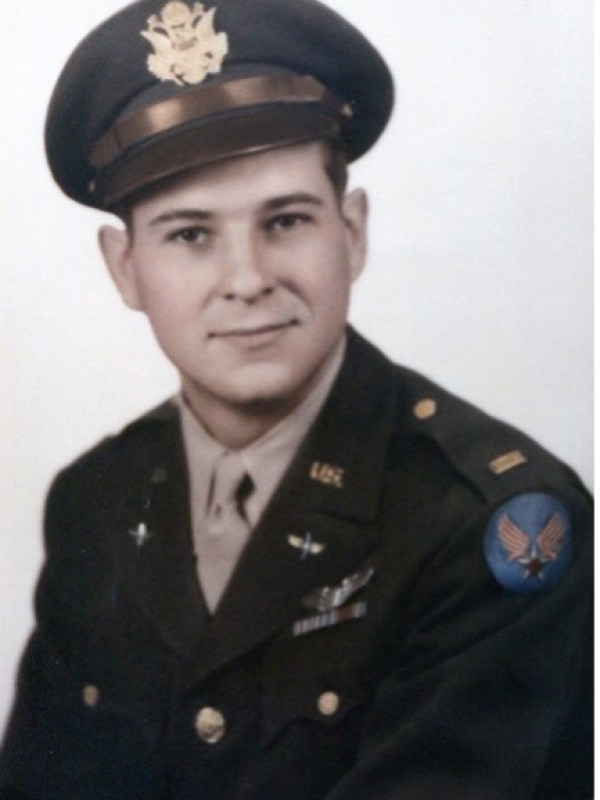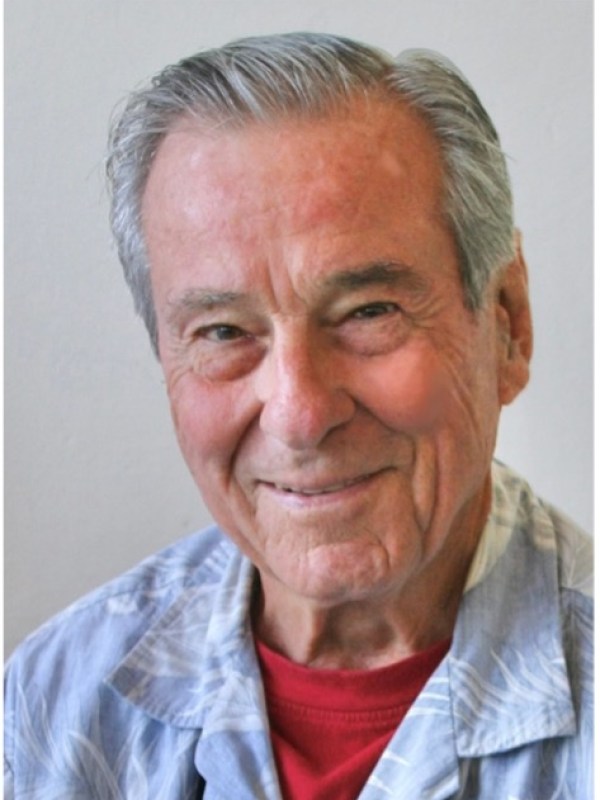George Sargent McKenzie
In a life so full that even 97 years couldn’t quite contain it, he embodied the greatest virtues of the “Greatest Generation,” at the heart of which were his love of family, country, and the community of Santa Barbara, where his roots reached back 7 generations. He served his country in WWII, returned home to marry a woman he’d admired since junior high, raised five children with her, and taught math and industrial arts to two generations of local students. On what would have been his 98th birthday, we, his children, memorialize and honor the life of George Sargent McKenzie.
He was born in Santa Barbara to William and Cora (Sargent) McKenzie. He and his older brother, William Jr., inherited their father’s pride in their local ancestors, who included Jose Francisco de Ortega (the Presidio’s first commander) and William Benjamin Foxen (the English merchant seaman who married Commander Ortega’s granddaughter). George often spoke of happy childhood memories: car trips with his dad inspecting rural lines for the phone company; pets (notably, ducks he raised from eggs, and homing pigeons); Boy Scout Troop 9; SB backcountry trips; fishing from Stearns Wharf; helping boat owners launch and land at the Harbor; tennis with his best friend at Oak Park; and summer labor at San Lucas Ranch to satisfy Coach Schutte’s football conditioning demands.
At Santa Barbara High School, he earned varsity letters as a runner on the track team and kicker on the football team. When WWII erupted, he was determined to serve as soon and well-prepared as possible, so added ROTC to his SBHS classes and, on graduation day, missed commencement exercises to board a troop train in LA. His military training took him first to Missoula, MT; then back to CA (Santa Ana Army Air Base, Rankin Field flight school at Tulare Army Air Base, and Gardner Army Airfield in Taft), where he learned to fly the Stearman bi-plane and Vultee BT-13; then to advanced flight training at Pecos Army Airfield, TX, where he earned his wings and became a Flight Officer; and finally to Roswell Army Airfield, NM, where he piloted the B-17 Flying Fortress.
After the war, he returned home and attended UCSB (Riviera campus). There, he rediscovered Barbara Ann Abbott, whom he’d first met in Harry Chanson’s Accordion Club in junior high. They married in 1948 and, after graduating in 1951, moved to Los Angeles so he could pursue a master’s degree in Education at USC. They settled in Hermosa Beach to start a family, but moved back home to Santa Barbara at the earliest opportunity.
For the next 30 years, George taught math and industrial arts in SB public schools, first as a substitute teacher at SBHS, then full-time at La Cumbre Junior High. When La Colina Junior High opened in 1959, principal Jack Richards invited George to join the faculty; George was delighted to accept, and was a popular and successful teacher there for many years. Then, to help his least senior colleague avoid layoff, George voluntarily transferred to San Marcos HS, where he was honored to serve as the head of the Math Department. After retirement, one of his greatest pleasures around town was when one of his many former students would stop to say hello, and thank him.
After Barbara’s death in 1994, George was re-introduced to their college friend, June York Behrens, who also was recently widowed. It was the beginning of a new life for both, and they seldom were apart until her death more than 16 years later. June welcomed George into her family, which became practically an extension of his own, and vice versa. Through June, he also gained new friends and interests. One new interest was travel: June was an avid world traveler, and became his guide and companion on wonderful trips throughout the U.S., Canada, Mexico, Caribbean, and Europe. He especially enjoyed Cuba, where his discovery of mojitos inspired him to add mint to his backyard gardens.
After June’s death, George was lucky enough to become reacquainted with Maxine Crandall, a sorority sister of his late wife. As two SB natives, he and Maxine shared many local memories, friends, and acquaintances. He especially enjoyed times the two of them spent with Maxine’s children and grandchildren, and the laughter-filled cruises he and Maxine took together with their respective families.
George often reflected on his good luck in life. He thought of it as “luck” because, characteristically, he focused not on what he’d done to deserve it, but on how mystified and grateful he was to have it. Over and over, with family, students, and community, the voice of that gratitude was generosity. He was honored by the Red Cross for his many donations of blood, platelets, and plasma, and he regularly made monetary donations to local charities and nonprofits to support causes that were important to him, particularly education (SBHS Alumni Association; SB Foundation), and preservation/study of both local nature (SB Museum of Natural History) and history (SB Trust for Historic Preservation).
When he wasn’t thinking about giving others what he had, he often was busy creating something (to give away, most likely). He had such a passion and gift for making and growing things that it was like a second language for communing with his world and the people in it. Useful things, decorative things, playful things—whatever their purpose, his creations came as much from his heart as from his hands and mind. He helped design and build the family home, to which he added masterful custom woodwork. He later added a barn and corral to the property, and horses added further to the population of pets that brought the family much happiness. He built a beautiful fishing boat and welded a trailer to fit it, patiently allowing his excited young son to “help.” Weekend and after-school outings on local waters provided many memorable hours of father-son time, and often a seafood feast for the family. His “green thumb” was legendary, as was his devotion to the backyard fruit trees, vegetables, and flowers on the foothill acre that was his home for his last 50+ years. To young eyes and some older ones, his workshop and yard creations verged on magical, but behind them were innumerable hours of thought, experimentation, and manual labor—all of which he seemed to enjoy as much as the results. As he headed out to do yardwork in his mid-90’s we’d say, “Don’t work too hard out there,” to which his reply was sure to be, “That’s not work!”
He fully believed in his own abilities. Limits, even those of old age, he took as challenges. “Don’t tell me what I can’t do” was a phrase he’d be proud to have as an epitaph. When presented with two possible choices, he’d challenge the assumption he was limited to one, reminding us with a smile that he was “Mr. Do Both.”
His natural athleticism was impressive, especially when fueled by his singular determination. When he underwent knee surgery in his 60’s, his orthopedist suggested swimming to strengthen the leg; George’s way of doing that was to become certified as a SCUBA diver. Although he enjoyed many sports, from his early teens his favorite was tennis, which he continued to play two or three days a week until nearly 90. He almost always played with the same group of fellow teachers, and enjoyed their friendship and comradery as much as the tennis. When there was a ping pong table around, he loved to pick up a paddle, and couldn’t suppress a smile when he dumbfounded an opponent with tricks he’d learned from a champion ping-ponger in his Army unit. As he got older, he also enjoyed Santa Barbara Lawn Bowls, where he made and renewed more valued friendships. Other fun with fellow schoolteachers included fishing trips, poker evenings, and BBQs where he was renowned for his grilled tri-tip and family-recipe Spanish beans
He never lost the love of aviation he’d found in the Air Corps. He earned his private pilot’s license in his 50’s, noting with amusement that his military flight log gave him more air hours than his civilian instructor had. The airport was a happy place for him, whether he was working as a docent at the SB Air Heritage Museum, just watching planes come and go, or—best of all—when time and money allowed him to rent a Cessna and soar over the local territory he knew so well.
He had an affinity for numbers, and relished the daily Sudoku puzzle, which he credited for keeping his mind sharp. The sharp mind and competitive spirit made him a formidable foe in family card and board games—he never “let” his young opponents win, but always was gracious in victory and quick to offer a rematch.
Among the most enduring gifts George gave his children were memorable experiences: trips to Don and Shirley’s Pony Rides (and train-watching with a 10¢ Coke from the machine, with the reminder—from someone who’d learned from the Depression the true value of things—that “those always used to cost a nickel”); Rancho Oso for trail rides; LA for Dodger games and amusement parks; Sierras and SB backcountry for camping/fishing; Santa Ynez Valley for family history (and, in later years, winetasting); local parks to hunt for mushrooms after rains; La Tolteca to watch that night’s dinner made by hand; and countless other warm memories.
With his family by his side, George completed his long and fruitful life’s journey at SB Cottage Hospital—the same place, as he enjoyed telling amazed staff, where it had begun more than 97 years earlier. He was pre-deceased by his wife Barbara and son Duncan, and is survived by his children Martin, Ellen, Robin, and Anne, son-in-law Mitch, grandson Owen, and extended family.
The family again thanks Complete Care at Home (especially caregivers Leah and Laurie), SB Cancer Center and UCLA Health (especially Dr. Fred Kass and PA Amanda Sweet), SB Cardiovascular Medical Group (especially Dr. Vishal Goyal), Dr. Darol Joseff, Montecito Geriatrics (especially Dr. Todd Fearer and Carrie Rydman), Dr. Eric Wipf and staff, Dr. Timothy Spiegel, Samarkand, Valle Verde, Cottage Hospital, and all the others without whose expert and compassionate care George could not have had such a long, active, and happy life.
Memorial services were private. Anyone wishing to make a donation in George’s memory may do so to their favorite charity or nonprofit, or to a cause George supported, some of which are listed above; remembrances may be left on the Welch-Ryce-Haider webpage (www.wrhsb.com).


